Driving in Ireland as a tourist doesn’t need to be scary. This way of getting around offers visitors an unparalleled way to explore the Emerald Isle’s stunning landscapes and hidden gems.
Personally, when I’m heading back home, I always rent a car as it gives my family and me the freedom to venture out of Dublin to discover charming villages, dramatic coastlines, and rolling green hills at our own pace.
While it can be scary for first-time visitors to Ireland, navigating Ireland’s winding country roads and quaint rural lanes allows for a truly immersive experience of the country’s rich culture and natural beauty.
The flexibility of having your own vehicle in Ireland is invaluable.
You can easily adjust your itinerary on a whim, stopping to admire breathtaking views, or popping into a cosy pub for a pint of Guinness (obviously not the designated driver) whenever the mood strikes. This spontaneity level is simply impossible when relying on public transport or guided tours.
While driving on the left side of the road may seem daunting at first, most visitors quickly adapt to this unique aspect of Irish motoring. The sense of adventure and independence that comes with driving in Ireland far outweighs any initial nervousness.
With a rental car, I’ve been able to create unforgettable memories with my family while exploring our homeland. So, here is everything you need to know about driving in Ireland as a tourist.
Note, that on February 7th 2025, the rural local roads speed limit in Ireland changed. This article has been updated to reflect the new limit on Irish roads. This article also shows the changes in speed limits coming to urban core roads and national secondary roads coming later in 2025.

- Understanding Ireland's Road Rules
- Licence Requirements for Tourists
- Renting a Car in Ireland
- Navigating Irish Roads
- Parking and Urban Driving
- Driving in Rural Ireland
- Tips for Safe Driving in Ireland
- Understanding Irish Fuel Stations
- Adhering to Ireland's Drink Driving Laws
- Emergencies and Breakdowns
- Cultural Insights for Driving in Ireland
- Conclusion
Understanding Ireland’s Road Rules
Driving in Ireland requires familiarity with local traffic regulations. I’ll cover the key rules tourists need to know to navigate Irish roads safely and legally.
Driving on the Left
In Ireland, we drive on the left side of the road.

This can be challenging for visitors accustomed to right-hand driving. I recommend practising in a quiet area before venturing onto busier roads. You could drive out of the car rental area and do a loop back to it to get a feel for things on the ‘wrong’ side.
Roundabouts are common in Ireland. When approaching, yield to vehicles already in the roundabout, that are approaching you from the right. Remember to enter and move in a clockwise manner.

At junctions without traffic lights, give way to the right. This is crucial for safe navigation, especially in rural areas where intersections might lack clear signage.
Speed Limits and Measurements
Ireland uses kilometres per hour (km/h) for speed limits. The national speed limits are:
- Motorways: 120 km/h
- National roads: 80 km/h (lowered from 100km/p in 2025)
- Regional and local roads: 60 km/h (lowered from 80km/h in February 2025)
- Built-up/urban core areas: 30 km/h (lowered from 50km/p in 2025)

Be aware that some areas may have lower limits. Always check the posted signs, as they take precedence over general limits.
Speed cameras are widely used throughout the country. I advise strictly adhering to limits to avoid fines or penalties.
Throughout Ireland, the police use mobile-speed camera vans that are usually parked in a hard to see place, so my advice is stick to the speed limits and let other drivers pass you if they want to chance breaking the limit.
Traffic Signs Specific to Ireland
Irish road signs are predominantly in English and Irish. Some unique signs to be aware of include:
- Yield sign: An upside-down triangle with ‘Yield’ or ‘Géill Slí’ written inside.
- Clearway: A blue sign with a red ‘X’, indicating no stopping during specified times.
- L and N plates: Displayed by learner and novice drivers respectively in their front and rear windows.

Watch for signs indicating narrow roads or bridges, especially in rural areas. These often require giving way to oncoming traffic.
Bóthar Dola signs indicate toll roads. Be prepared to pay, either at booths or through electronic systems for some motorways. If you do not have a toll tag in your rental car (either given over the counter or already installed in the window), ensure you stop at the booths.
And be aware that if you do not have a toll tag, and cross the M50 in Dublin, you need to pay it before 8pm the day after your journey.
Licence Requirements for Tourists
Tourists driving in Ireland need to be aware of specific licence requirements. These vary depending on your country of origin and age.
International Driving Permit
As a tourist, I can use my valid driving licence from the country I live in without needing any additional paperwork as it is an EU/EEA country.
For EU/EEA licences, no additional documents are needed. Visitors from other countries should check if they need an IDP. Some nations have agreements with Ireland, allowing their licences to be used without an IDP, such as Australia, the US and Canada.

However, if my licence wasn’t in English, I would need an International Driving Permit (IDP) as well. Should you require an International Driving Permit, make sure you get it before your trip.
Most car rental companies will have information on their websites regarding countries where an IDP is required alongside the valid licence.
It’s important to carry both your home licence and IDP (if required) when driving in Ireland.
Age and Documentation
The minimum age for driving in Ireland is 17. As a tourist, however, most rental companies will not rent cars to those aged 17 years of age.
Many rental car companies have additional age requirements. They often require drivers to be 21 or older, with some setting the minimum age at 25. Extra fees may apply for younger drivers, and not all companies will rent cars to under 25s.
If renting a car in Ireland you need to ensure your driving licence is valid and not expired. Carrying proof of identity, such as a passport, is also advisable.
It’s crucial to check the specific requirements of the car rental company you plan to use.
Renting a Car in Ireland
Renting a car in Ireland offers flexibility and freedom to explore the country at your own pace. It is my preferred method of exploring Ireland.
I’ll guide you through the key considerations to ensure a smooth rental experience.
Choosing the Right Vehicle
When selecting a car, I recommend considering the size of your group and luggage. For solo travellers or couples, a compact car is ideal for navigating narrow roads and finding parking in towns, depending on the amount of your luggage.
Families or larger groups might prefer a mid-size vehicle or even two smaller cars for added flexibility. That said, mid-sized vehicles in Ireland can often feel smaller than mid-sized US vehicles.
Automatic transmissions are less common in Ireland, so booking early is crucial if you’re not comfortable with manual gears. Keep in mind that smaller cars are often more fuel-efficient and easier to manoeuvre on rural roads.
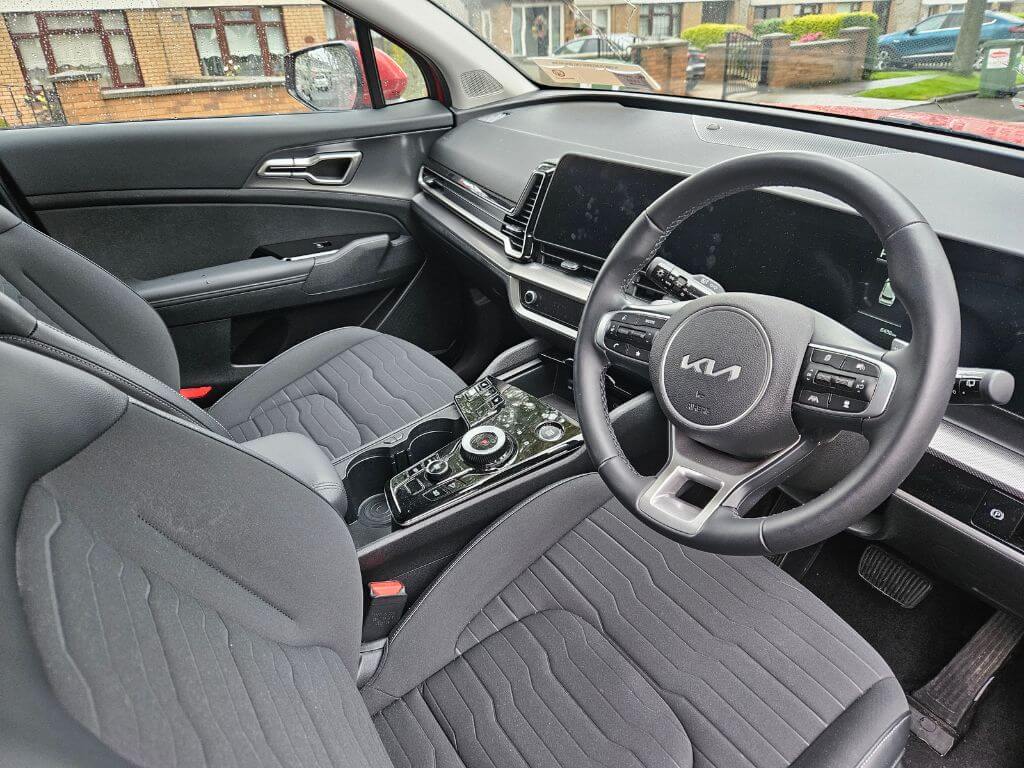
Manual transmission cars are also the cheapest option because they are the most popular type of transmission, meaning automatics are more expensive.
If you’re arriving at an airport and will be touring Ireland, I suggest comparing rates between Dublin and Shannon. Dublin typically offers more choice, but Shannon can be less hectic for first-time visitors adjusting to driving on the left.
Insurance Options
Insurance is a vital aspect of car rental in Ireland. Rental car agreements usually come with a Collision Damage Waiver (CDW) as a minimum. This covers most damage to the rental car but often comes with a high excess.
For peace of mind, I recommend Super CDW, which reduces or eliminates the excess. It’s pricier but can save you from unexpected costs if an accident occurs. It also makes returning a car super easy as you just hand the keys back and off you go.
Remember, country roads in Ireland are narrow, often lined with bushes or stone walls. And you can get caught out if a local comes tearing down the road towards you.
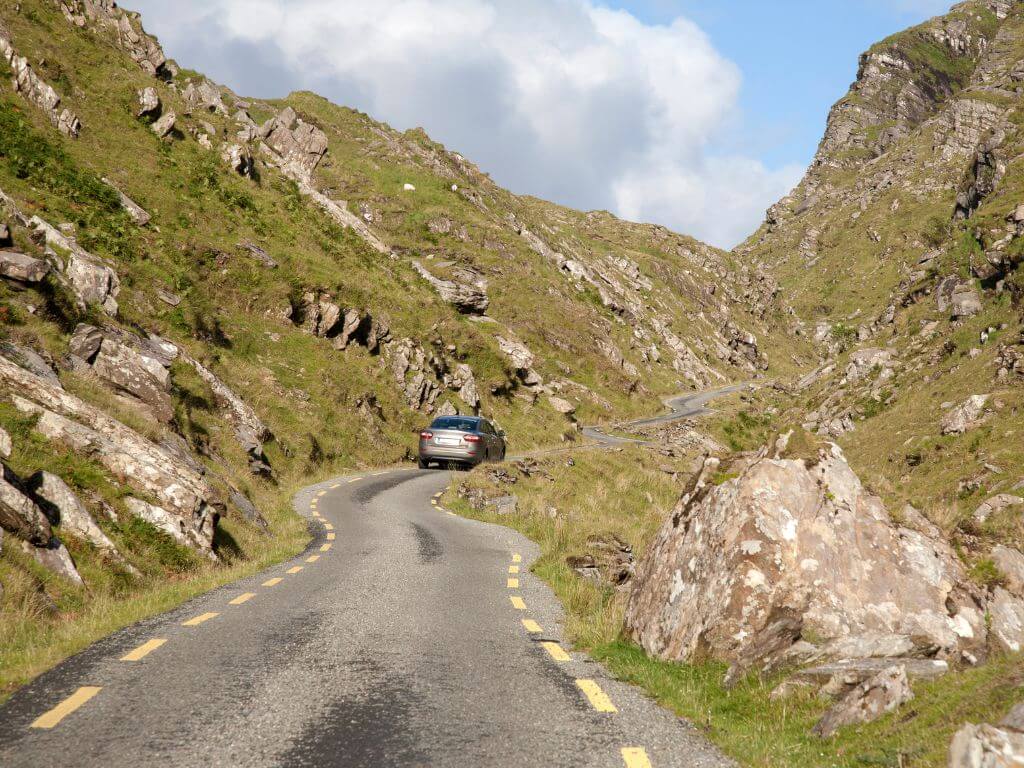
Some credit cards offer rental car insurance, but I advise checking the terms carefully. Many exclude Ireland or have limitations on coverage.
Many rental car companies in Ireland will not accept third-party insurance which means you will have a large excess placed on your credit card. In the event something happens, the rental company will retain part of or all of this excess and you will need to claim it back from your third-party insurer later.
Rental Agreement Essentials
When signing your rental agreement, I urge you to read it thoroughly. Pay attention to fuel policies – some companies require a full tank return, while others offer a ‘full-to-full’ option.

Check the mileage limits, as unlimited mileage isn’t always standard. I suggest estimating your planned route to avoid extra charges. Some companies will say a mileage limit or unlimited mileage on their online booking process.
This is very important, inspect the car carefully before driving off. I always take photos of any existing damage and even a video, and ensure it’s noted on the agreement. This protects you from being charged for pre-existing issues upon return if you do not have SCDW insurance.
Lastly, familiarise yourself with the return process. Some airports have specific drop-off points, and knowing these in advance can save time and stress at the end of your trip.
At Dublin Airport, some drop-offs are available in Terminal 2 but all Terminal 1 drop-offs are at a separate location a few minutes away from the terminal buildings and require you to take one of the complimentary buses to the terminal after you have dropped your rental car off.
Navigating Irish Roads
Driving in Ireland presents unique challenges for tourists, but with proper preparation and awareness, it can be an enjoyable experience. I’ll share essential tips for navigating Irish roads safely and efficiently.
Using GPS and Maps
I recommend using GPS for navigating Ireland. However, if you are not comfortable with GPS, a combination of GPS and paper maps for navigation in Ireland may be useful.
While GPS is generally reliable, it’s wise to have a backup. I always download offline maps on my smartphone before travelling. Google Maps and Waze are excellent options, offering real-time traffic updates and alternative routes.
Paper maps are invaluable in rural areas where mobile signal might be weak. I suggest purchasing an up-to-date road atlas from a petrol station or bookshop upon arrival.
I also spend a little time familiarising myself with routes using Google Street View before setting off and this has proven incredibly helpful, especially when locating parking in a city, town or at a tourist site.
Understanding Irish Road Types
Irish roads are categorised into three main types: motorways, national roads, and regional roads.
Motorways, marked with an ‘M’, are similar to British motorways. They’re the fastest routes between major cities and have blue backgrounds on their signs.
National roads, prefixed with ‘N’, connect large towns and cities. Primary routes are marked with green signs. Regional roads, indicated by ‘R’, serve local traffic and often pass through small towns and villages.

Rural roads can be narrow and winding. I always drive cautiously on these, as you never know what you might come up against around a corner. Sometimes you need to use designated passing places to let oncoming traffic through, so watch out for these on small, country roads.
Toll Roads and Payment Methods
Ireland has several toll roads, mainly on motorways. The M50 around Dublin uses a barrier-free system, where you must pay online or at certain retailers within 24 hours of using the road.

For other toll roads, you can pay cash at toll booths. Some offer contactless card payments. If I’m planning extensive travel, I consider getting an electronic tag for quicker passage through toll plazas, if my rental car company offers it.
It’s crucial to budget for tolls when planning journeys. Toll charges vary depending on the road and vehicle type. I always keep some euro coins handy for cash-only tolls. You can find more information on tolls here.
Parking and Urban Driving
Navigating urban areas in Ireland presents unique challenges for tourists. Parking spaces can be scarce, and traffic congestion is common in larger cities.
City Parking Rules
I’ve found that most Irish cities use pay-and-display parking systems. It’s crucial to locate a ticket machine, purchase a ticket for the desired duration, and display it clearly on your dashboard. Parking spaces are often tight, so I recommend practising your parallel parking skills.
Some places use number plate recognition systems, where it reads your car registration number on entry, and you must use this to pay your parking and then will be allowed out of the car park. Such an example is Liffey Valley Shopping Centre in Dublin.
In cases where you do not receive a ticket upon entry, take a picture of your number plate to enter into the payment machines before you try to leave the car park.

In Dublin, I’ve also noticed that parking can be particularly tricky. Many areas have resident-only parking, and fines for violations are steep. I always look out for clear signage indicating parking restrictions and time limits. A giveaway that non-residential parking is allowed is parking payment machines.
When visiting smaller towns, I’ve discovered that free parking is more common. However, it’s still wise to check for any time restrictions to avoid unwelcome surprises. Also, be on the lookout for car park payment machines.
Dealing with Traffic in Cities
I’ve learned that driving in Dublin can be quite stressful for those who are new to the country or nervous drivers.
The city centre is often congested, and one-way systems can be confusing for visitors. Recently, new congestion restrictions have also come into force, making navigating the city centre tricky, even for locals. This is why I prefer using public transport when exploring the capital.

In other cities like Cork or Galway, I find driving more manageable. Still, I always plan my route and try to avoid peak hours. GPS navigation is invaluable, but I keep an eye out for unexpected road closures or diversions.
Roundabouts are very common in Irish cities. While I am used to them, other visitors might not be. It’s important to yield to traffic already in the roundabout and use indicators when exiting.
Remember to watch for cyclists and pedestrians, especially in busy urban areas. They often share the road, so remain extra vigilant.
Driving in Rural Ireland
Rural Ireland offers a unique driving experience with its charming country roads and occasional agricultural encounters. I’ll share some key insights to help you navigate these areas safely and enjoyably.
Country Roads and Scenic Routes
Ireland’s rural roads are often narrow and winding, demanding extra caution. I’ve found that reducing speed is crucial, especially on blind corners. Many of these routes lack hard shoulders, so I always stay alert for oncoming traffic, especially locals who know the road and aren’t expecting anyone else to be using them!
The scenery can be breathtaking, but I resist the urge to sightsee while driving. Instead, I plan stops at designated viewing points. Sometimes you might see a viewing point pull-in point but not always.

It’s wise to keep an eye out for local drivers who might be more familiar with the roads and drive at a quicker pace.
I’ve learnt to be prepared for unexpected road conditions. Potholes, loose gravel, and muddy patches are not uncommon. Checking the weather forecast before setting off is a good habit, as heavy rain can make rural roads slippery.
Livestock and Agricultural Machinery
Encountering farm animals on rural roads is a common occurrence in Ireland. I’ve come across sheep, cows, and even the occasional horse. Slowing down and giving animals a wide berth is essential.
During harvest seasons, I’m extra vigilant for large agricultural vehicles. These machines often take up most of the road, so patience is key. I always pull over safely when possible to let them pass.
And if you drive up behind them, do not be tempted to overtake them. You do not know what is in front of them, whether there is a bend in the road or if there is an oncoming car. Be patient as they will eventually turn down another country lane or into a farm field.
Farm gates opening directly onto roads can be another hazard. I keep an eye out for farmers moving livestock between fields. Sometimes, temporary electric fences might be set up near the roadside, so maintaining a safe distance is crucial.

I’ve found that a courteous approach goes a long way. Waving to local farmers or fellow drivers fosters goodwill and makes the journey more pleasant for everyone.
Tips for Safe Driving in Ireland
Driving safely in Ireland requires awareness of local conditions and staying alert. I’ll share some key tips to help you navigate Irish roads confidently and securely.
Weather Considerations
Ireland’s weather can be unpredictable, so I always prepare for changing conditions.
Make sure the rental car’s windscreen wipers are in good nick before leaving the airport and ensure the tyres have proper tread depth. This is essential to do before you drive away from your rental car company collection point.
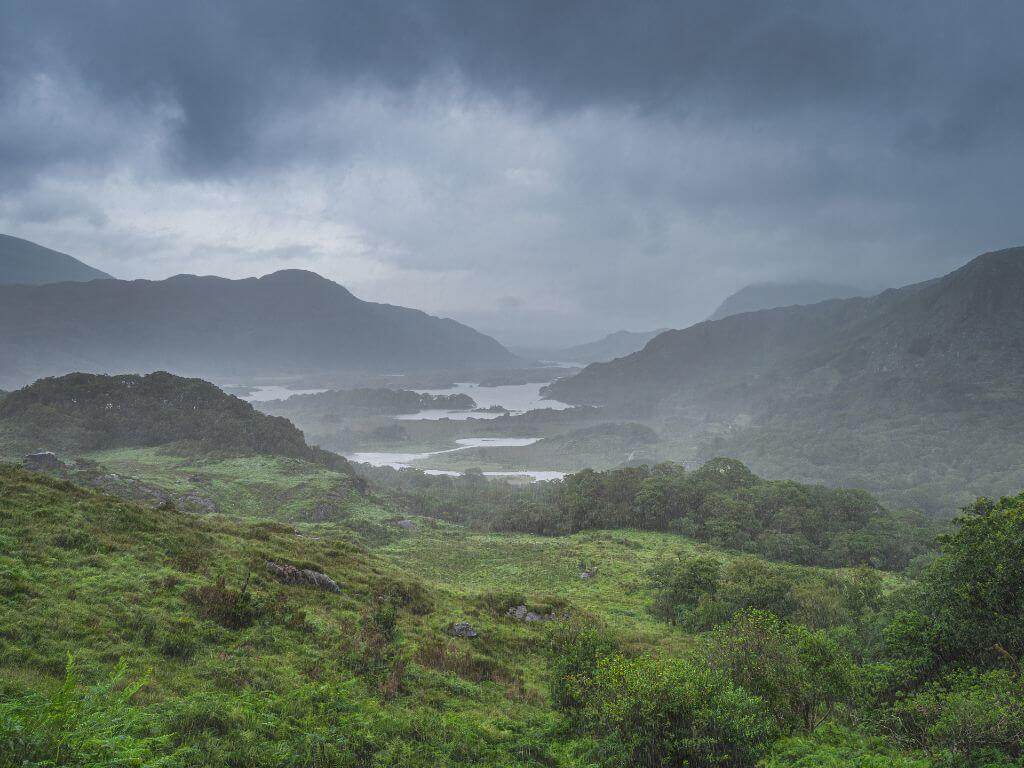
When it’s raining, I slow down and increase my following distance. Fog is common, especially in rural areas, so I use fog lights when needed. Just remember to turn them off when visibility improves!
In winter, I’m extra cautious of icy patches on roads, particularly in shaded areas. I reduce my speed and avoid sudden braking or steering. It’s wise to see if there is a scraper and de-icer in the car for frosty mornings. If not, you might be able to buy these in a garage or large Tesco store.
Staying Safe on Longer Journeys
On extended drives, I take regular breaks to combat fatigue. I plan stops every couple of hours, stretching my legs and getting fresh air. If you’ve just arrived on a long-haul flight, avoid driving a long distance immediately and give yourself time to adjust.
I always check my route beforehand and programme my sat-nav before setting off. This helps me stay focused on the road rather than fiddling with directions. I keep my mobile phone out of reach to avoid the temptation of using it while driving.
Staying hydrated is crucial, so I keep water in the car. I also make sure I’m well-rested before embarking on long journeys across Ireland.
Understanding Irish Fuel Stations
Irish fuel stations offer essential services for tourists driving in Ireland. They provide various fuel types and payment options to meet different needs.
Types of Fuel Available
Most Irish petrol stations sell both petrol and diesel. It’s crucial to double-check which fuel your rental car requires before filling up. Ask at the rental car desk so you know before leaving the airport.
Petrol is typically labelled as ‘unleaded’ and comes in different octane ratings. The most common are 95 and 98 RON. Both work just fine in Irish cars.
Diesel is widely available and often preferred by many Irish drivers. Some stations also offer premium diesel options. If you’re driving an electric vehicle, charging points are becoming more common at fuel stations, especially along major routes. But make sure you plan stops for charging so you aren’t caught out.
Personally, I prefer to have a fuel car or a hybrid so I never find myself in trouble.

Payment Options
I’ve found that Irish fuel stations accept various payment methods. Cash is always welcome, and most stations take major credit and debit cards. Some larger chains have their own fuel cards for regular customers.
Be aware though that American Express is not a commonly-accepted form of payment.
Pay-at-pump services are available at many stations, allowing for quick refuelling without entering the shop. These typically require a credit or debit card. Inside the shop, you can often pay with contactless methods or mobile payments like Apple Pay or Google Pay.
It’s wise to carry some cash as a backup, especially in rural areas where card machines might not always work reliably.
Adhering to Ireland’s Drink Driving Laws
Ireland takes drink driving seriously, with strict laws and penalties in place to promote road safety. I’ll explain the legal limits and consequences for those who don’t comply.
Legal Blood Alcohol Levels
In Ireland, the legal blood alcohol concentration (BAC) limit is 50 milligrams of alcohol per 100 millilitres of blood for most drivers. However, for professional, learner, and novice drivers, the limit is lower at 20 milligrams per 100 millilitres.
It’s important to note that these limits can be reached with very little alcohol consumption. Even one pint of beer or a small glass of wine could put you over the limit.
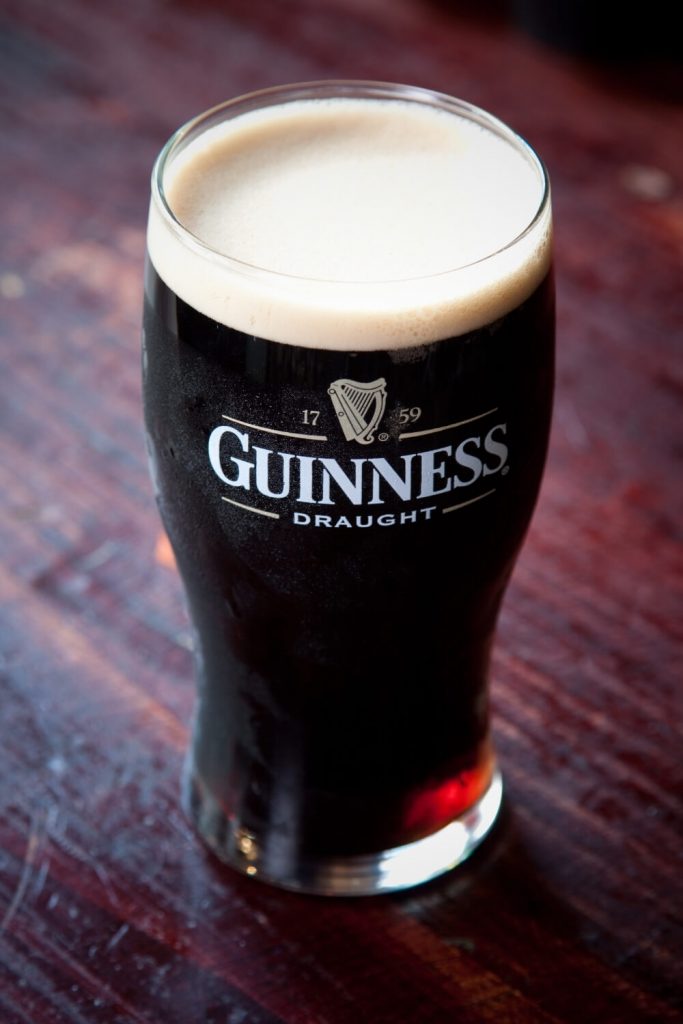
I am tee-total so don’t need to worry. However, to stay safe, you should avoid drinking any alcohol if you plan to drive. It’s the surest way to comply with the law and protect yourself and others on the road. Take a taxi instead.
Penalties for Non-Compliance
If you are caught driving over the legal limit in Ireland, you can face severe penalties. These can include fines, driving bans, and even imprisonment in some cases.
For a first offence, you could receive:
- A fine of up to €5,000
- A driving disqualification for at least 3 months
- Up to 6 months in prison
The penalties increase for repeat offences or higher BAC levels. For instance, if your BAC is between 80-100mg, you face a 1-year driving ban for a first offence.
You also need to be aware that refusing to provide a breath, blood, or urine sample when requested by the Gardaí (Irish police) carries the same penalties as failing the test.
Emergencies and Breakdowns
When driving in Ireland as a tourist, it’s crucial to be prepared for unexpected situations on the road. I’ll cover how to access roadside assistance and important emergency contact numbers to keep handy during your trip.
Accessing Roadside Assistance
If I find myself in a breakdown situation whilst driving in Ireland, I have several options for roadside assistance. Many car rental companies offer 24/7 emergency support, which I can usually reach by calling the number provided in my rental agreement.
Make sure this is pointed out to you at the rental car desk at your pick-up point. If it is not, ask for it!
For more comprehensive coverage, visitor might consider joining the AA Ireland or RAC, which offer temporary membership for visitors. These services can help with issues like flat tyres, dead batteries, or mechanical failures.
If I were not covered by any assistance programme, I could still call local garages or tow services. It’s wise to research and save contact details for garages along your planned route before setting off.

Emergency Contact Numbers
In case of a serious emergency on Irish roads, you need to know the correct numbers to call for help. The primary emergency number in Ireland is 999 or 112, which you can use to contact the Gardaí (police), ambulance, or fire services.
For non-emergency situations, you can reach the Garda Traffic Watch at 1800 333 666 to report road hazards or traffic issues.
It’s also helpful to save the contact details for your embassy or consulate in Ireland. They can provide support if you are involved in a serious incident or require legal assistance.
You should program these numbers into your mobile phone and keep a written copy in your car for quick access in stressful situations.
Cultural Insights for Driving in Ireland
Understanding local customs and etiquette is crucial for a smooth driving experience in Ireland. I’ll share key cultural insights to help you navigate Irish roads confidently.
Cultural Norms and Practices
In Ireland, driving is a social activity. You may notice that Irish drivers often wave or nod to acknowledge other motorists, especially on rural roads. It’s polite to reciprocate these gestures. This is something I love about driving down the country.
Punctuality isn’t as strict in Ireland as in some other countries. If you’re running late for an appointment, it’s generally acceptable within reason.
However, I recommend allowing extra time for journeys, as traffic can be unpredictable. If you are running really late, it is advisable to stop and call your appointment/reservation person to explain the situation.
Irish people are known for their friendliness. If you’re lost or need directions, don’t hesitate to ask locals. I’ve found that most are happy to help and might even go out of their way to assist you.
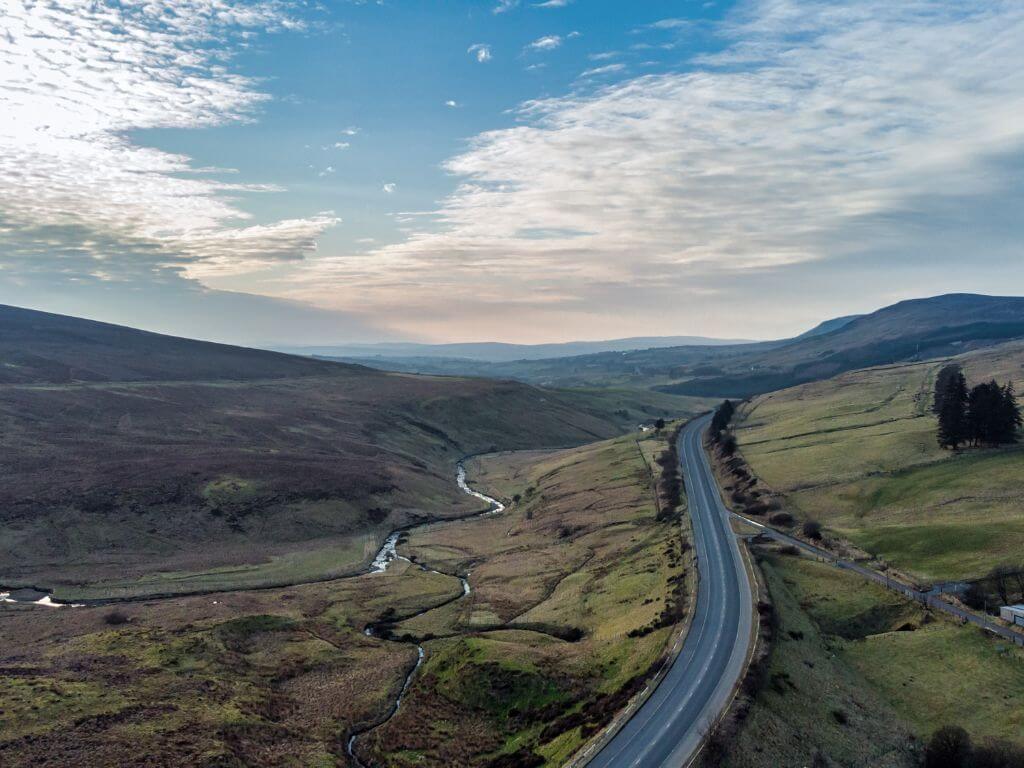
Local Driving Etiquette
When driving in Ireland, patience is key. Rural roads can be narrow, so it’s common to pull over to let oncoming traffic pass. A friendly wave is appreciated in these situations.
Irish drivers tend to be more relaxed about lane discipline than in some other countries. However, I always strive to maintain proper lane position, especially on motorways.
Tailgating is frowned upon. I make sure to keep a safe distance from the vehicle in front, particularly in wet conditions which are common in Ireland. If someone is tailgating me, I find a safe place to pull in and let them overtake me.
Indicating is important, but I’ve noticed that some Irish drivers may not signal as frequently as you might expect. It’s best to stay alert and anticipate other drivers’ actions.
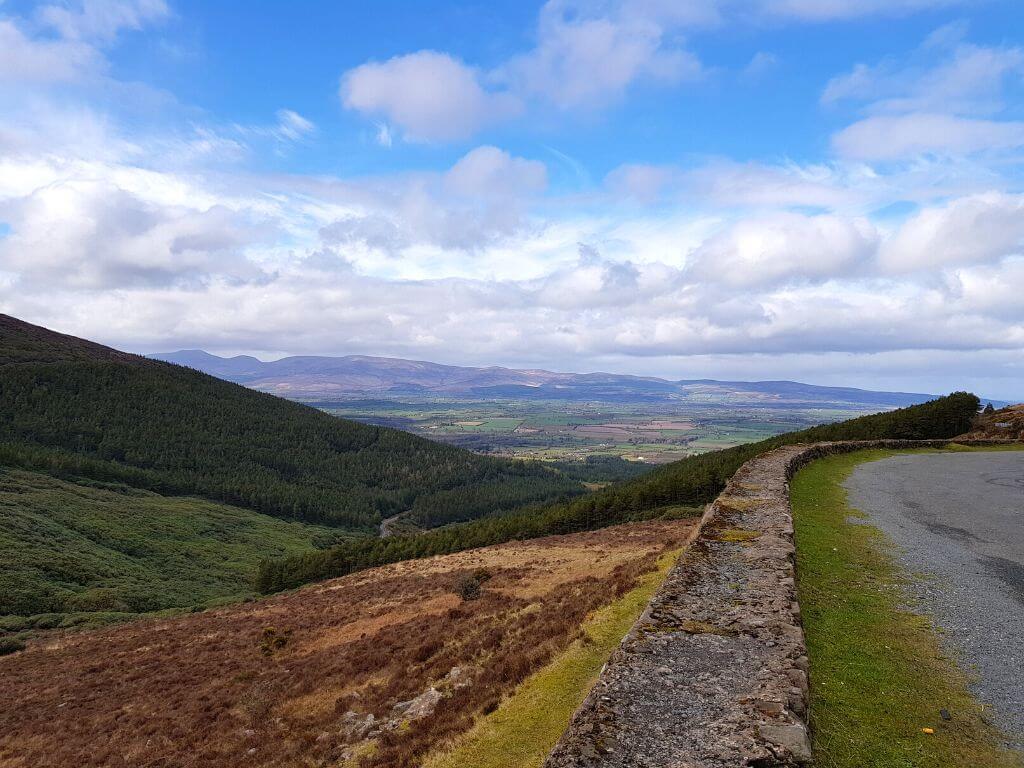
Conclusion
Driving in Ireland as a tourist can be an incredible experience. I’ve covered the key aspects to ensure a smooth journey on the Emerald Isle’s roads.
Remember to drive on the left and familiarise yourself with local road signs and rules. Renting a car is straightforward, but choose a size you’re comfortable with for narrow country lanes.
Stay alert for changeable weather and potential hazards like sheep or cattle crossing rural roads. Embrace a relaxed pace and take breaks to soak in the scenery.
I recommend planning your routes in advance but don’t hesitate to detour for unexpected discoveries. That’s the joy of a road trip in Ireland!
With these tips in mind, you’re well-prepared for an unforgettable driving adventure. Enjoy the freedom of the open road and create lasting memories of Ireland’s beauty.
You also need to read these:
Pin for later!



